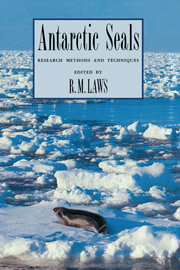Book contents
- Frontmatter
- Contents
- List of contributors
- Preface
- Introduction
- 1 Identification of species
- 2 Estimation of population sizes
- 3 Immobilization and capture
- 4 Marking techniques
- 5 Telemetry and electronic technology
- 6 Behaviour
- 7 Killing methods
- 8 Morphometrics, specimen collection and preservation
- 9 Genetic-based studies for stock separation
- 10 Collection of material for the determination of organochlorine and heavy metal levels
- 11 Age determination
- 12 Reproduction
- 13 Diet
- 14 Bioenergetics
- 15 Development of technology and research needs
- 16 Appendices
- Index
8 - Morphometrics, specimen collection and preservation
Published online by Cambridge University Press: 05 February 2010
- Frontmatter
- Contents
- List of contributors
- Preface
- Introduction
- 1 Identification of species
- 2 Estimation of population sizes
- 3 Immobilization and capture
- 4 Marking techniques
- 5 Telemetry and electronic technology
- 6 Behaviour
- 7 Killing methods
- 8 Morphometrics, specimen collection and preservation
- 9 Genetic-based studies for stock separation
- 10 Collection of material for the determination of organochlorine and heavy metal levels
- 11 Age determination
- 12 Reproduction
- 13 Diet
- 14 Bioenergetics
- 15 Development of technology and research needs
- 16 Appendices
- Index
Summary
Introduction
In the past much of the information on seal biology was obtained from post-mortems carried out on animals taken commercially, killed for dog food or specifically for the purpose of biological research. However, few species are now commercially exploited – certainly no Antarctic species – and very few seals are taken for dog food; also there has been a change in public attitudes on killing animals for scientific purposes and non-destructive methods can now be used to obtain much of the data formerly obtained in that way (e.g. capture, drug immobilization, blood sampling and telemetry). Nonetheless, some information and material is still only obtainable from post-mortem examination and so standard methods for collection of data, samples and specimens from dead animals are described here. Animals should not be killed unless absolutely necessary.
Historically, many measurements and specimens and samples were taken from all animals collected or captured. However, this is time consuming and often the material is not used. In this chapter we have largely restricted ourselves to the collection of data and specimens from the three areas most relevant to research and management needs in population ecology:
fundamental cataloguing of the original specimens, samples and essential measurements;
age determination;
reproductive status.
The collection of skeletal material is also described here. Studies of food habits are also important; the collection of complete stomachs (and intestines) from killed seals is described in chapter 13.
- Type
- Chapter
- Information
- Antarctic SealsResearch Methods and Techniques, pp. 161 - 171Publisher: Cambridge University PressPrint publication year: 1993
- 9
- Cited by



